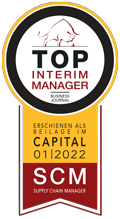

Richard Porstmann
Process optimization in the company – the key to sustainable success
Reading time: 6 minutes
Table of contents
While 10 years ago process management was described as a “modern management discipline”, 83% of the companies surveyed from different sectors and of different sizes now state that process management plays an essential role for them in a successful company.¹
This result and the forecast that this figure will continue to rise are not surprising. In an era characterized by constant change and growing competition, companies are faced with the crucial question of how they can become more efficient, competitive and profitable. The answer to this question often lies in the art of process optimization.
But process optimization is more than just a buzzword; it’s a fundamental approach to transforming your business to maximize performance and efficiency. And when it comes to realizing these changes, there is a valuable ally: the interim manager.
¹ Business Process Management Study 2023, Analysis of the status quo 2022 and developments within the last eleven years in the context of BPM, A study by the Institute of Information Systems in cooperation with BOC Group, ZHAW School of Management and Law, Authors: Tim Geppert, Björn Scheppler, Felix Meentken, Sandro Gerussi & Elke Brucker
Advantages at a glance
More efficient processes often mean lower operating costs, as fewer resources are wasted. This can lead to considerable cost savings.
An optimized process structure creates transparency regarding tasks, responsibilities and key performance indicators, which improves decision-making.
By introducing strict quality control procedures in production, errors and rejects can be minimized, resulting in higher quality end products.
The optimization of work processes leads to better use of resources and time, resulting in increased efficiency and productivity.
Process optimization promotes a culture of continuous improvement and innovation, which makes companies more competitive.
Process optimization in 3 steps

Situation analysis and problem diagnosis
In this first step, as an interim manager I carry out a comprehensive situation analysis to identify weaknesses, inefficiencies and bottlenecks. This includes a comprehensive process audit and the identification of bottlenecks in business processes.
Process redesign
Based on the results of the situation analysis, a customized process optimization strategy is developed. This includes the definition of KPIs (Key Performance Indicators), the determination of recommended actions for process improvement, the allocation of resources and the creation of a detailed implementation plan.
As an interim manager, I take on the role of change manager during the implementation of process optimization. I orchestrate the transformation process by involving employees, conducting training, allocating resources effectively and ensuring that the implementation takes place according to the specified schedule.
Process follow-up
After implementation, the optimized processes are continuously monitored using advanced performance analysis methods. A dashboard for real-time monitoring is set up to ensure that the defined KPIs are achieved. Adjustments are made where necessary to ensure that processes are in line with changing requirements and industry best practice.
Process optimization with Richard Porstmann
Words alone cannot bring about change. The question now is: Are they ready to take the next step? Are you ready to question, optimize and revolutionize your business processes?
If you want to increase the growth, efficiency and competitiveness of your company, then don’t hesitate! Together we will determine the specific needs of your company and develop a customized strategy for process optimization. I’m here to help you achieve your goals and take your business to the next level. Contact me and start your journey to process optimization and long-term success.
Conclusions
- The continuous improvement of business processes is crucial in order to remain competitive in a rapidly changing market environment. Increasing efficiency and improving quality are key components for long-term success.
- Process optimization should not be seen as a one-off project, but as an integral part of the corporate culture. A culture of continuous improvement promotes innovation and adaptability.
- Interim managers play an important role in the implementation of process optimization. Their expertise and experience enable companies to react quickly to problems and implement changes effectively.
If you have any suggestions or thoughts on this topic, please write to me.






